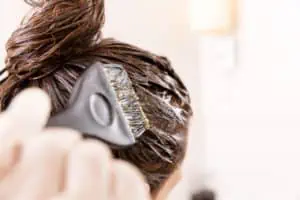
Medically reviewed by: Camila Yepes, PA-C
Dyeing your hair is a fun way to change up your look or keep the grays from showing. But for some people, it’s not as simple as dyeing, rinsing and enjoying. For those with a hair dye allergy or sensitive skin, itching and inflammation can take the fun away.
Then there are those annoying hair dye stains. If certain dyes get on your face or fingers, the stains can seem impossible to remove, sending you running to your nearest electronic device to Google “How to get hair dye off skin.”
Camila Yepes, PA-C, a physician assistant at Water’s Edge Dermatology, has these tips to help make your next dye job a success.
Do you have a hair dye allergy or sensitivity?
Allergic contact dermatitis is a skin allergy to a common substance, and hair dye can be one of those substances. Hair dye reactions are also triggered by sensitivities, which are different from allergies. Irritant contact dermatitis happens when an irritant aggravates the skin by damaging its outer layer.
“You can develop a hair dye allergy or a sensitivity to the ingredients in your hair dye at any time,” said Yepes. “It can happen even if you’ve been dyeing your hair with the same product for years.”
If you develop a reaction to the dye, each time you dye your hair, the reaction may happen faster (in a few days or a few hours), be more severe and last longer.
Most reactions to hair dye are caused by an ingredient called paraphenylenediamine (PPD), found in permanent dye and some semi-permanent dyes. You’re more likely to develop a reaction if you use darker shades of dye, which contain more PPD.
“PPD is a popular ingredient in hair dye because it provides long-lasting color,” said Yepes. “Its potency is also what makes any dye stains you get on your skin so hard to remove.”
PPD allergies are relatively uncommon, affecting 5% of people in the U.S. “Sensitivities are more common, particularly in people who have eczema,” said Yepes.
Hair dye allergy and sensitivity symptoms
Whether you’re allergic to PPD or just sensitive to it, the symptoms are largely the same. They can include swelling, peeling, a red rash and stinging or burning. Both allergies and sensitivities can cause itching, though it’s more likely to be a major symptom if you’re allergic to PPD.
Blistering is more common in allergic reactions, while sensitivities are more likely to make skin dry and cracked.
In rare cases, a hair dye allergy can trigger a potentially fatal allergic reaction called anaphylaxis, which can cause swelling of the tongue and throat, difficulty breathing, nausea and vomiting. Your risk of anaphylaxis is higher if you’ve had it before or if you have allergies or asthma and a family history of anaphylaxis.
How to avoid hair dye reactions
Avoiding reactions comes down to taking a few precautions and switching hair dye if you need to.
Always do a patch test. Before applying the dye, dab a small amount on a patch of skin in an inconspicuous area, then wait 48 hours. Reactions don’t always happen immediately, so don’t cut the time short. If the skin swells, turns red, burns or itches, you shouldn’t use the dye. If you develop symptoms of anaphylaxis, call 911 or go to the ER immediately.
Protect your skin in advance. Cover areas that may come in contact with the dye, such as the hairline, ears and neck, with petroleum jelly to prevent the dye from spreading beyond your scalp. Wear gloves to protect your hands.
Try a PPD-free hair dye. If you’re allergic to or sensitive to hair dye, ask your colorist to use PPD-free dye. While there is no special hair dye for eczema sufferers, PPD-free options may be less likely to cause a problem. If you’re coloring your hair at home, look for brands that don’t contain PPD, such as Madison Reed and Clairol Natural Instincts.
What to do if you have a reaction
If you develop a reaction to hair dye while it’s still on your hair, wash it out immediately with warm water and a mild shampoo. “Do this even if your symptoms are subtle because they could get worse,” said Yepes.
If you notice a reaction afterward, Yepes recommends applying an over-the-counter topical corticosteroid cream (0.5-1% hydrocortisone) to ease discomfort and inflammation. If you also feel itchy, taking an antihistamine medication such as Benadryl can help.
Symptoms often go away on their own or with home treatment, but if they don’t, or if you see signs of infection, such as pus, call your dermatologist.
How to get hair dye off skin
Hair dye stains are the other “dark” side of PPD. If you get dye on your skin, wipe it away ASAP to prevent it from sinking in.
If you see stains after you’ve dyed your hair, start by washing the area with soap and warm water. For more set-in stains, rub the area with olive oil and leave the oil on your skin for up to eight hours. This is the best approach for people with sensitive skin. If sensitivity isn’t an issue, dab the stain with rubbing alcohol or non-gel toothpaste and let it sit for 5 to 10 minutes before washing it off.
Stains on the hands can be removed by rubbing a cotton ball dipped in nail polish remover on the skin for a few seconds, or doing the same with a paste made of gentle dish soap and baking soda.
Article Written By: Jessica Brown, a health and science writer/editor based in Nanuet, New York. She has written for Prevention magazine, jnj.com, BCRF.org, and many other outlets.





